NavSource Online: Submarine Photo Archive
Viper / B-1 (SS-10)
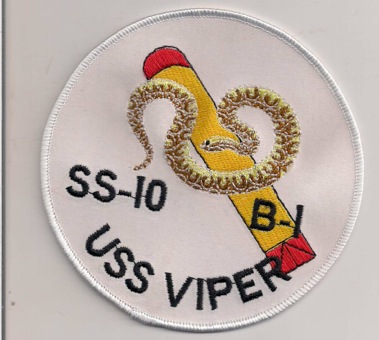
Contributed by Don McGrogan, BMCS, USN (ret.)
Please report any broken links or trouble you might come across to the Webmaster.
Please take a moment to let us know so that we can correct any problems and make your visit as enjoyable and as informative as possible.

![]()
![]()
![]()
| Click On Image For Full Size | Size | Image Description | Source | |
|---|---|---|---|---|
 | 59k | Viper (SS-10) being launched at the Fore River Shipbuilding Co., Yard at Quincy, MA., on 30 March 1907. | Insert Image and text provided by University of Utah, Marriott Library. Photo from Deseret Evening News. (Great Salt Lake City [Utah]) 1867-1920, 18 October 1907, Last Edition, Image 7, via chroniclingamerica.loc.gov. Picture and info from "The Romance of A Submarine" by G Gibbard Jackson & submitted by Robert Hurst. |
|
 | 221k | The B class: Viper (SS-10), Cuttlefish (SS-11), & Tarantula (SS-12), the ultimate development of the single screw Holland design, introduced a much more extensive superstructure for sea keeping. As designed, Viper had only the single periscope shown, as in Plunger, it was let into the conning tower. A second (hull) periscope was later added. Engine gearing had been abandoned, the propeller shaft no longer coincided precisely with the axis of the hull. Air compressors and main bilge pumps were driven from the main shaft via clutches and gears; they could be operated by either the motor or the engine. Note that, in a boat this small, a reload torpedo occupied much of the hull. | Collection of Rear. Admiral Henry Williams. USNHC photograph Text courtesy of U.S. Submarines Through 1945, An Illustrated Design History by Norman Friedman. Naval Institute Press. | |
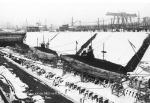 | 103k | The three B-boats (SS-10/12) (Inboard) Cuttlefish (SS-11), Tarantula (SS-12), and Viper (SS-10) share a snowy dry dock at the New York Navy Yard, 25 January 1908. Note that each one still has a single fixed periscope, with a flagstaff above it. Boats running submerged flew flags on these staffs to warn surface ships against running them down. Note, too, the running lights affixed to boards on the foremasts. | Collection of Rear. Admiral Henry Williams. USNHC photograph Text courtesy of U.S. Submarines Through 1945, An Illustrated Design History by Norman Friedman. Naval Institute Press. |
|
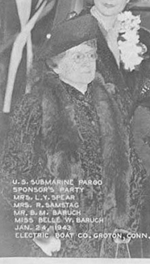 0801088 |
152k | The Viper (SS-10) was sponsored by Mrs. Lillian Wing Spear, wife of Lawrence York Spear, naval architect and general manager of the Electric Boat Company. She appears here at the launching of the Pargo (SS-264). | Electric Boat photo courtesy of George K.Chastain, Executive Director of The Belle W. Baruch Foundation.
Great thanks to John Spivey, who looks for things to make this website better. |
|
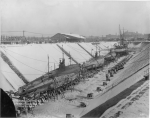 | 470k | Viper (SS-10), Cuttlefish (SS-11) and Tarantula (SS-12) lie together in dry dock at the New York Navy Yard, 25 January 1908. | NARA (National Archives and Record Administration) photo # 19N15-28-6, courtesy of Daniel Dunham. | |
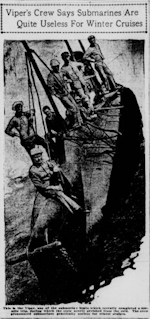 |
NR | Viper's (SS-10) Crew Says Submarines Are Quite Useless For Winter Cruises | Image and text provided by Central Michigan University, Clark Historical Library. Photo from The Detroit Times. (Detroit, Mich.) 1903-1920, 19 May 1908, FIRST EDITION, Image 1, via chroniclingamerica.loc.gov. | |
 |
NR | SUBMARINES FOR THE PACIFIC | Image and text provided by Washington State Library; Olympia, WA. Photo from Aberdeen Herald. (Aberdeen, Chehalis County, W.T.) 1886-1917, 09 November 1908, Image 7, via chroniclingamerica.loc.gov. | |
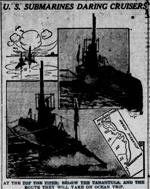 | NR | U. S. SUBMARINES DARING CRUISERS AT THE TOP THE VIPER (SS-10); BELOW THE TARANTULA AND THE ROUTE THEY WILL TAKE ON OCEAN TRIP. An adventure watched with interest by the navy officials and by thousands throughout the country is the cruise of four submarines from Philadelphia to Charleston, S. C. The boats are the Tarantula, Viper, Cuttlefish (SS-11) and Octopus (SS-9). |
Image and text provided by Washington State Library; Olympia, WA. Photo from The Spokane Press. (Spokane, Wash.) 1902-1939, 12 November 1908, Image 7, via chroniclingamerica.loc.gov. |
|
 | 1.45k | In New York Harbor for the 1909 naval review, with the New York & Cuba Mail docks in the background the Viper (SS-10) shows both her periscopes and a substantial false bow (superstructure) above her pressure hull. There were few limber holes because these boats were not expected to dive quickly. Note the temporary bridge for surface navigation. | USN photo by Enrique Muller, from NARA # 19-N-13457, courtesy of Daniel Dunham. Text courtesy of U.S. Submarines Through 1945, An Illustrated Design History by Norman Friedman. Naval Institute Press. |
|
 | 102k | Viper (SS-10) in port, with members of her crew on deck, circa 1907-1911. Tarantula (SS-12) is behind her. | USNHC photograph # NH 38. | |
 0801004 | 721k | Cuttlefish (SS-11), Tarantula (SS-12), and Viper (SS-10) in port, circa 1909. | Photo courtesy of history.navy.mil | |
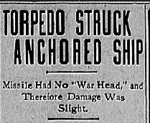 | 1.53k | TORPEDO STRUCK ANCHORED SHIP A missile shot from the torpedo tube of the submarine Viper (SS-10) is said to have come within an ace of smashing in the side of the William F. Green as she lay quietly at anchor in the cove yesterday afternoon. The Viper is one of the four government submarines now manoeuvring here with Admiral Schroeder's fleet. | Image and text provided by Library of Virginia; Richmond, VA. Photo from The Times Dispatch. (Richmond, Va.) 1903-1914, 23 July 1909, Image 1, via chroniclingamerica.loc.gov. | |
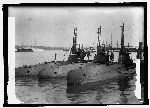 | 117k | All three B-class submarines at Annapolis, MD, 1910. From left to right: Cuttlefish (SS-11), Viper (SS-10), & Tarantula (SS-12). In the background on the left is the cruiser Olympia (C-6) and in the center is an unidentified C or D class submarine. | Text courtesy of David Johnston. Digital ID # 19799, LC-F81-2433. Source: Library of Congress Prints and Photographs Division, National Photo Company Collection. | |
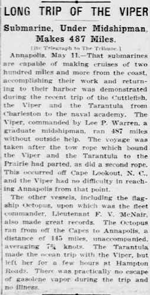 | NR | LONG TRIP OF THE VIPER (SS-10). Submarine, Under Midshipman, Makes 487 Miles. | Image and text provided by Library of Congress, Washington, DC. Photo from New-York Tribune. (New York [N.Y.]) 1866-1924, 12 May 1910, Image 1, via chroniclingamerica.loc.gov. | |
 | 87k | Photo of the Viper (SS-10), possibly with the Reserve Torpedo Group at Charleston Navy Yard. Photo is inscribed with "Friend George" & "KID BUSTER", " B-1 (SS-10)", addressed to Clarence Isaiah Maxson, circa 1911-12. Note the # 11 on her periscope shears. | Photo courtesy of Vern Maxson, LCDR(SS), USNR-Retd, partial text courtesy of DANFS. | |
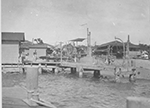 |
514k | Submarine base at Cavite. Manila, Philippine Islands. 31 appears on the conning tower of the pierside sub as crewmen move a torpedo alongside. Note: The above photo has a vertical # 11 on her shears, so that leads me to believe that the boat in this photo is either B-1 or B-3. But keep in mind that those squadron identifiers sometimes changed, so you can not rely on them to positively ID the boat, only as an indicator. I have also seen a pic of a C-class boat with a vertical # 11, making the use of those squadron identifiers as an ID method a bit problematic. Notice the 18 inch Whitehead Mk 3 torpedo on the pier next to the boat and its relatively small size compared to the WWII 21 inch Mk 14. |
Text courtesy of David Johnston Photographer: Committee on Public Information National Archives Identifier: 45511421 Local Identifier: 165-WW-328E-4 Photo courtesy of catalog.archives.gov |
|
 |
447k | B-3 (SS-12) with the 31 on her hull and an officer in dress whites looking at her sisters as they sail in the Philippine Islands. | National Archives Identifier: 45513801 Local Identifier: 165-WW-338B-54 Photo courtesy of catalog.archives.gov |
|
 0801016 |
610k | Post card photo of the B-1 (SS-10) at the Cavite Naval Base, Philippines, where she served from 1915/ 1921 with the 2nd Submarine Division in Manila Bay. | Photo courtesy of Rick Karlslyst. | |
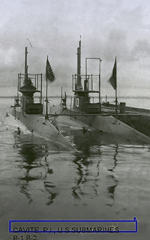 | 67k | B-1 (SS-10), (inboard) & B-2 (SS-11) at the Cavite Naval Base, Philippines, 1916. | Photo courtesy of Vern Maxson, LCDR(SS), USNR-Ret. Photo fix by Jim Keeling. | |
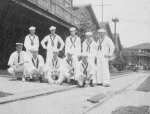 | 66k | Crew of the B-1 (SS-10), at the Cavite Naval Base, Philippines, 1916. | Photo courtesy of Vern Maxson, LCDR(SS), USNR-Ret. | |
 | 80k | A-7 (ex-Shark) (SS-8) right B-1,(ex-Viper) (SS-10), center in Philippine waters, during the Nineteen-"Teens". Both show the submarine bells used for underwater communication ( B-1's is on her foredeck, A-7's abaft her conning tower). Note how rudimentary their bridges were. | USNHC photograph # NH 69710. Text courtesy of U.S. Submarines Through 1945, An Illustrated Design History by Norman Friedman. Naval Institute Press. | |
| Back To The Main Photo Index | Back To the Submarine Index |
| Problems and site related matters, E-mail Webmaster |
| This page is created by Gary Priolo and maintained by Michael Mohl All Pages © 1996 - 2024 NavSource History |